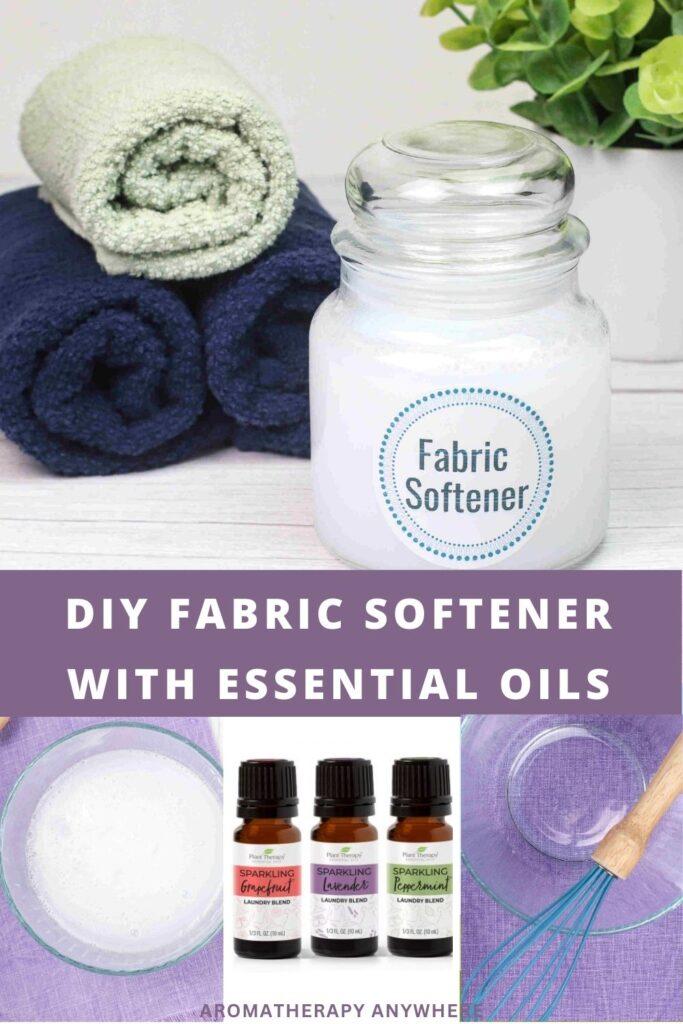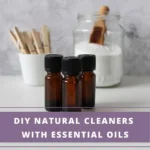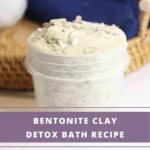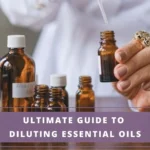As an Amazon Associate I earn from qualifying purchases. See Full Disclosure Here
Using a homemade fabric softener with essential oils offers a more natural, eco-friendly, and affordable solution to keeping your clothes soft and fresh-smelling.
When you use a homemade fabric softener recipe, you’ll have complete control over the ingredients and can avoid the use of any harsh chemicals.
 As you’ll see in the instructions, it’s easy to make your own fabric softener with essential oils. Essential oils add a pleasant fragrance to your laundry.
As you’ll see in the instructions, it’s easy to make your own fabric softener with essential oils. Essential oils add a pleasant fragrance to your laundry.
The best part You can choose from a range of scents depending on your personal preference.
Whether you’re new to the world of essential oils or a seasoned pro, you’re sure to love this simple and effective DIY project.
What Is Fabric Softener And How Does It Work?
A fabric softener is a laundry product that’s added to the wash cycle to eliminate static and soften clothes.
It also reduces wrinkles in the fabric, making it easier to iron.
Fabric softener works by depositing a thin layer of lubricant on the fibers of the clothes, which helps them feel softer and smoother. The lubricant also reduces wrinkles and eliminates static, which can be a problem in very dry weather.
Homemade Fabric Softener Recipe
There are several variations of the basic recipe for fabric softeners. In this particular recipe, I show you how to make fabric softener with conditioner.
After the recipe, I explain how each ingredient works and why it’s added to fabric softener recipes. I’ve also included tips for buying the ingredients.
– 3 cups White Vinegar
– 1 cup Hair Conditioner
– 4 cups Warm Water
– 2 teaspoon Baking Soda
-10-20 drops Essential Oil
– Large bowl
-Whisk
– Funnel (if needed)
-Mason jar or any airtight glass jar
Instructions
Step 1 Add the hair conditioner and warm (not hot) water in the bowl. Whisk until well combined. The warm water makes it easier to smooth any clumps from the conditioner.
Step 2 Mix in the vinegar and whisk lightly.
Step 3 Whisk in the baking soda and essential oils. That’s it!
Step 3 Transfer your homemade fabric softener into a clean container for storage. Use a funnel if you need to.
Store the fabric softener in a cool, dry place away from direct sunlight.
This recipe will keep for 1-2 weeks when stored in an airtight container.
The result is a super soft fabric that’s very close to what you’d achieve with any commercial fabric softener but without any synthetic ingredients.
How Each Of The Ingredients Works
White Vinegar
Laundry detergent can leave behind alkaline residues that build up over time and make fabrics feel stiff and rough.
Vinegar is acidic in nature and when added to a homemade fabric softener recipe, it neutralizes these alkaline residues, so fabrics feel softer and smoother.
Vinegar also has natural anti-static properties that help reduce static cling in fabrics, making them easier to handle and wear.
When adding vinegar to a homemade fabric softener, make sure to add only as much as listed in the recipe. Too much vinegar can cause fabrics to become stiff and crunchy.
Baking Soda
Baking soda is a naturally alkaline substance that helps balance the pH level of fabrics.
Acidic residues from sweat and body oils that may be left behind on clothing after washing cause the fabric to become stiff and scratchy. When added to homemade fabric softener recipes, baking soda helps to neutralize these acidic residues so the fabric feel softer and fresher.
When using baking soda in a homemade fabric softener, it’s important to mix it thoroughly with the other ingredients to ensure that it dissolves completely in the water.
Using too much baking soda can also cause fabrics to feel stiff or gritty, so it’s best to start with a small amount and adjust as needed based on personal preference and the needs of your laundry.
Hair Conditioner
Hair conditioner contains ingredients such as cationic surfactants and fatty alcohols that soften and condition fabric fibers the same way it does hair strands.
When added to the fabric conditioner recipe, hair conditioner coats the fabric fibers making them feel softer and smoother to the touch.
Any cheap brand of conditioner is fine as long as it is mild and doesn’t contain any strong dyes or harsh chemicals that could damage fabrics. Don’t waste your money on an expensive product – it won’t make any difference.
Look for a mild-scented or non-scented conditioner as that will interfere with the aroma of the essential oils.
Essential Oils
 The benefit of adding essential oils is that you can choose the scent you want to add to your laundry.
The benefit of adding essential oils is that you can choose the scent you want to add to your laundry.
Citrus blends add a fresh, clean aroma to sheets and curtains while floral blends give feminine clothing a lovely gentle fragrance.
You can use single essential oils or use these essential oil blends to the basic fabric softener recipe
Citrus Blends
– 4 drops each of Bergamot, Wild Orange, Tangerine
– 4 drops each of Lemon and Wild Orange + 2 drops Lime
– 5 drops each of Grapefruit & Tangerine + 3 drops Lime
Fresh-Scented Blends
– 8 drops Lavender + 6 drops Eucalyptus
– 8 drops Siberian Fir + 7 drops Roman Chamomile
– 10 drops Wild Orange + 5 drops Peppermint
Floral-Citrus Blend
– 5 drops each of Lavender, Patchouli, and Wild Orange
– 8 drops Roman Chamomile + 6 drops Lemon
How To Use Your Homemade Fabric Softener
Shake well before using, as the mixture may separate over time.
Use about 1/4 to 1/2 cup of the fabric softener per load of laundry, depending on the size of your load and your personal preference for softness.
You can use this directly in your washing machine according to your manufacturer’s directions or if you are using reusable dryer sheets, you can add this to your container of dryer sheets.
Homemade Fabric Softeners FAQs
 Does fabric softener damage clothes?
Does fabric softener damage clothes?
Overuse of fabric softener can cause clothes to become less absorbent, especially towels and other items made of cotton. It’s important to follow the recommended usage instructions and not to use too much.
Can fabric softener be used with all types of fabrics?
Fabric softener is generally safe to use with most types of fabrics, but some synthetic fabrics like athletic wear and swimwear may not absorb it as well.
Check the label on the fabric or garment for specific care instructions.
Can fabric softener be used with other laundry products?
Fabric softener can be used with most other laundry products, such as detergent and stain removers. However, you should not mix bleach and fabric softener, as this can produce harmful fumes.
Homemade fabric softener is easy to make, cost-effective, and sustainable. Made with natural ingredients, this fabric softener leaves clothes fresh, soft, and with a lasting scent.
Enjoy making your own all-natural products using essential oils? You may also enjoy these:
DIY Room Spray With Essential Oils
Make Your Own Closet Sachets With Essential Oils
Make Your Own Reed Diffuser With Essential Oils
DIY Relaxing Pillow Spray With Essential Oils
 Disclaimer: This information is not intended to serve as medical advice. Please consult your doctor before using any natural medication or if you experience any unusual symptoms. See Full Disclaimer here.
Disclaimer: This information is not intended to serve as medical advice. Please consult your doctor before using any natural medication or if you experience any unusual symptoms. See Full Disclaimer here.









